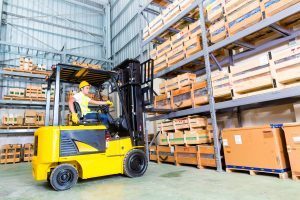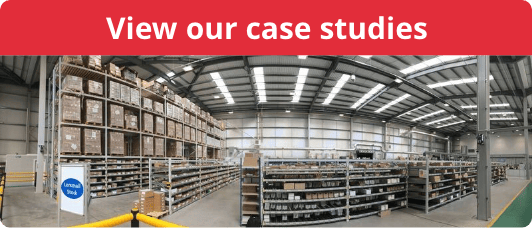Top Tips for Forklift Safety in the Warehouse
Fork Lift Safety in the Warehouse
 We have said it time and time again, and we’re about to say it again. We cannot stress enough the importance of health and safety in the workplace. From correct moving and handling practices to proper signage there are a host of responsibilities you have as an employer.
We have said it time and time again, and we’re about to say it again. We cannot stress enough the importance of health and safety in the workplace. From correct moving and handling practices to proper signage there are a host of responsibilities you have as an employer.
And, although we haven’t previously covered it in great detail, fork lift driving is a major factor.
Whilst our Facebook page is all fun and games with our #FridayFail, which often features dangerous near misses with warehouse fork lifts, the potential for harm is very real. Have a read below as we discuss what provisions you need to put in place to ensure the safety of your employees.
General Forklift Practices
The powered industrial truck is used to lift and move materials short distance and is therefore ideal for use in the warehouse and similar environments.
However, forklifts can be particularly dangerous in the warehouse. In fact, on average they are forklifts are involved in a quarter of all workplace transport accidents which is on the whole largely due to insufficient training on forklifts for employees.
Fork Lift Training
According to the Health and Safety Executive forklift training should always include three stages as detailed below:
- Basic Training: Employees should be equipped with the basic skills and knowledge required to operate a lift truck safely as well as efficiently.
- Specific Job Training: Drivers should be provided with the knowledge and understanding of the operating principles and controls of the lift truck and how these will be used within their specific working environment.
- Familiarisation Training: Employees should be given the opportunity to apply what they have learnt under the normal working conditions of their new employment.
There is no specific requirement detailing the length of training as there are many issues that will affect the rate of an individual’s learning. Simply, training should be as long as it takes to meet all of the requirements.
In addition, it is important that even those who have received previous training, and therefore considered experienced, are routinely monitored in the workplace and when necessary tested or required to undergo refresher forklift training.
Basic Rules and Top Tips
We have compiled a handful of fork lift safety rules, as well as some excellent tips, to ensure that both employer and employee, as well as additional warehouse employees, are not put in a position of danger.
- Qualifications – As mentioned above, and perhaps the most important aspect of fork lift safety is ensuring that ALL future employees receive the proper and adequate training. Without these measures you will putting all employees at serious risk.
- Clothing – Appropriate clothing including safety work wear such as hard hats, safety shoes, and hi-visibility jackets should be worn at all times. In addition, all clothing needs to be reasonably fitted to avoid the risk of any loose clothing being caught in the machinery.
- Routine Checks – Just as you should be carrying out routine checks on your Pallet Racking, you should take the time to carefully examine the equipment on a daily basis. Ensure that you check for any faults, particularly focusing on the brakes, steering, controls, warning devices, masts, and tyres.
- The Environment – The driver should always pay attention to and carefully follow any site rules and guidelines. It is therefore your duty, as an employer, to ensure that the correct signage is in place and clearly visible to all employees. The operator must only drive the equipment in the machinery’s designated roadways to avoid collision and ensure that all signs are observed; especially those that lay out the rules for loadings and clearance heights.
- Don’t Speed – We’d hope that this one was a given but we’re including it anyway. Just as you should obey The Highway Code, drivers of fork lift trucks should never exceed the instructed speed limit. Corners and turns should be taken slowly to avoid tipping and coming to a stop should be gradual and slow.
- Avoid Hazards – We understand that this one is often easier said than done, but drivers should try and steer clear of any bumps, uneven ground surfaces, and slippery conditions. We’d suggest making use of the horn when closing in on a corner or doorway to alert pedestrians and other drivers of your presence to avoid unnecessary collisions.
- Never Overload – Ensure that you and your drivers know the capacity of the vehicle as well as any attachments and never exceed these. An overload can cause rear tyres to raise off the ground and could cause the truck to tip over.
- Clear Visibility – Never operate the truck if visibility is poor. Carry a load low to the floor to allow for improved forward visibility or alternatively choose to reverse. When stacking, ensure that you have a good view of the rack or top stack where a load should be positioned. However, we understand that poor visibility is inevitable; in this case we suggest that you employ a lookout or helper to ensure that no individuals are put at risk.
- Correct Equipment Use – Do not let other people ride on the equipment unless a second seat is fitted as the vehicles are designed to carry loads and not additional bodies.
More Help and Information
Whether you need a bit of advice regarding your warehouse operations, or are in need of updating or additional pallet racking give our team a call. Just dial 01179 555 211 and our knowledgeable and friendly team will be happy to lend you a hand.
Alternatively, why not check out our blog? We offer some great advice regarding all areas of warehousing which could help you ensure smooth, safe operations.
